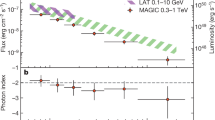Abstract
Cygnus X-3 remains a puzzling and controversial source of ultra-high-energy radiation, E≳O.l PeV (1 PeV = 1015eV). At these energies the radiation is variable1–3, with periodicity 4.8 h and a prominent peak at phase ∼0.2 during 1976–1980 and at phase ∼0.6 after 1984. There are outstanding difficulties in explaining both the phase diagram of the radiation and also the high luminosity in particles, Lp = 1040 erg s−1. In existing data, TeV and sometimes PeV radiation has been seen episodically; such an episode is connected with the radio flare of Cyg X-3 in October 1985, when PeV radiation with no phase structure was seen. The PeV pulse was detected5 3–5 days after the radio flare. It was suggested6 that this delay could be explained by introducing a massless free gluon as an intermediary, but here I propose a more natural explanation in which gamma-photons of PeV energy are absorbed by radio radiation inside the source. After a delay, the gamma radiation emerges as the radio flux diminishes and absorption decreases.
This is a preview of subscription content, access via your institution
Access options
Subscribe to this journal
Receive 51 print issues and online access
$199.00 per year
only $3.90 per issue
Buy this article
- Purchase on Springer Link
- Instant access to full article PDF
Prices may be subject to local taxes which are calculated during checkout
Similar content being viewed by others
References
Samorski, M. & Stamm, W. Astrophys. J. 268, L17–21 (1983).
Lloyd-Evans, J. et al. Nature 305, 784–786 (1983).
Alekseenko, V. V. et al. Proc. 19th int. Cosmic Ray Conf., La Jolla 91–94 (1985).
Berezinsky, V. S. Proc. 20th int. Cosmic Ray Conf., Moscow, 1987 (in the press).
Alekseenko, V. V. et al. Proc. 20th int. Cosmic Ray Conf., Moscow 229–232 (1987).
Arbuzov, B. A. Soviet Phys. JETP (Lett.) 42, 430–432 (1985).
Bhat, C. L. et al. Proc. 20th int. Cosmic Ray Conf., Moscow, 1987 (in the press).
Baltrusaitis, R. M. et al. Proc. 20th int. Cosmic Ray Conf. Moscow 233–235 (1987).
Molnar, A. et al. Proc. Workshop Stellar Continuum Radio Astronomy, Bouldercolo 329–334 (1985).
Mason, K. O., Córdova, F. A. & White, N. E. Astrophys. J. 309, 700–706 (1986).
Apparao, K. M. V. Astrophys. J. 287, 338–340 (1984).
Protheroe, R. J. & Stanev, T. Proc. 20th int. Cosmic Ray Conf., Moscow 258–261 (1987).
Berezinsky, V. S. Soviet Phys. Yadernaya Fizika 11, 399–407 (1970).
Author information
Authors and Affiliations
Rights and permissions
About this article
Cite this article
Berezinsky, V. Time delay of the PeV gamma ray burst after the October 1985 radio flare of Cygnus X-3. Nature 334, 506–507 (1988). https://doi.org/10.1038/334506a0
Received:
Accepted:
Published:
Issue Date:
DOI: https://doi.org/10.1038/334506a0
Comments
By submitting a comment you agree to abide by our Terms and Community Guidelines. If you find something abusive or that does not comply with our terms or guidelines please flag it as inappropriate.



